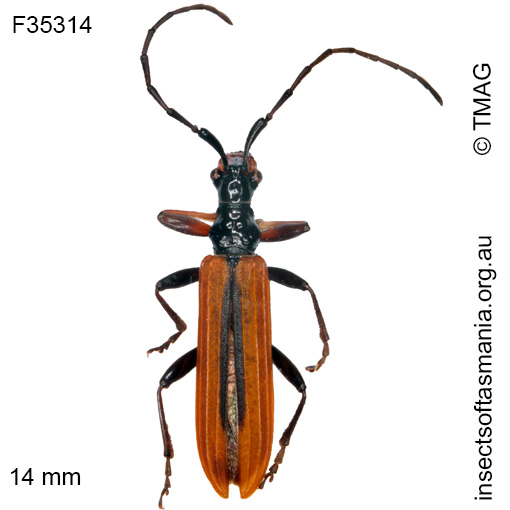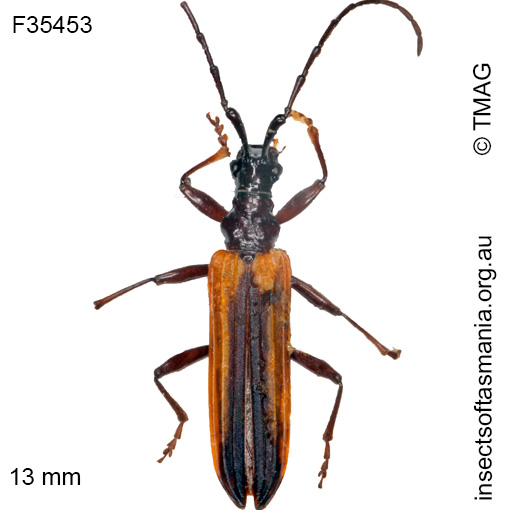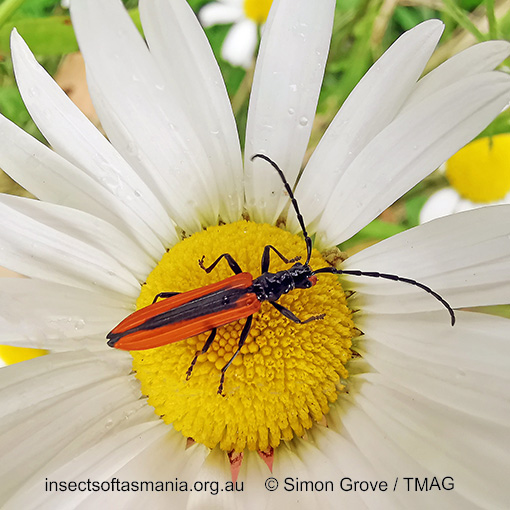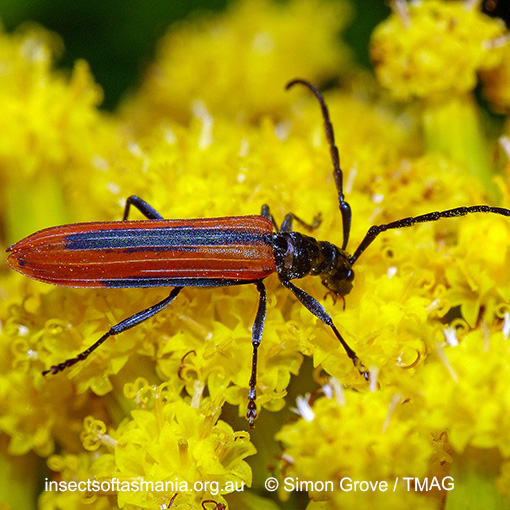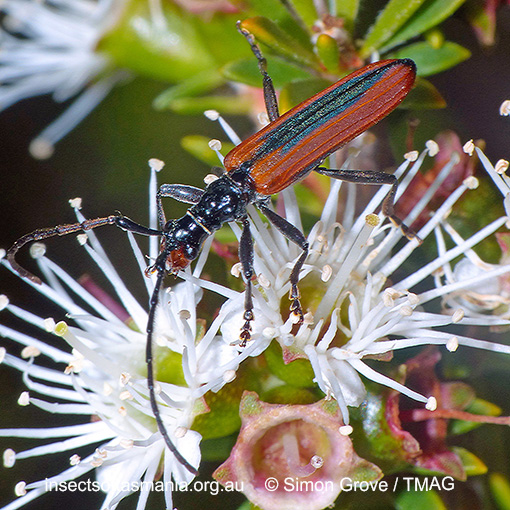
Stenoderus suturalis
Basis for Tasmanian occurrence
TMAG collections
Classification
Suborder: Polyphaga
Superfamily: Chrysomeloidea
Family: Cerambycidae
Subfamily: Cerambycinae
Tribe: Rhagiomorphini
Morphology
Flightedness: winged and assumed capable of flight
Source literature on morphology and taxonomy (*primary taxonomic source, where identified):
Ślipiński, A. & Escalona, H. (2016). Australian longhorn beetles (Coleoptea: Cerambycidae), Volume 2: Subfamily Cerambycinae. CSIRO publishing, 640 pp.
Ecology
Association with dead wood or old trees: obligately saproxylic
Ecological attributes: — Acacia dealbata is a host-plant (Bashford, 1990a) — Allocasuarina littoralis is a host-plant (Bashford, 1990a) — Cassinia aculeata is a host-plant (Bashford, 1990a) — Eucalyptus obliqua is a host-plant (Bashford, 1990a) — Breeds in dead or dying Acacia dealbata trees (Bashford, 1991) — May occupy logs or trunks of Eucalyptus obliqua, at least temporarily, since found having emerged within a year of felling (Grove & Bashford, 2003) — May occupy logs or trunks of Eucalyptus obliqua, at least temporarily, since found having emerged within six years of felling (Grove et al., 2009).
Collection method(s) for TMAG material: — Baited trapping (funnel trap) — Emergence trapping from log of Eucalyptus obliqua — Flight intercept trapping — Hand collection (substrate not specified) — Hand collection from Eucalyptus sieberi — Hand collection from flowers of Cassinia aculeata — Hand collection from flowers of Eucryphia lucida (Ettershanks & Ettershanks, 1993) — Malaise trapping — Not specified — Pipe trapping — Pitfall trapping — Rearing in insectary (host not documented) — Rearing in insectary from Acacia dealbata — Rearing in insectary from Cassinia aculeata — Rearing in insectary from Eucalyptus obliqua — Rearing in insectary from Eucalyptus viminalis — Rearing in insectary from Pittosporum bicolor — Sticky trapping (substrate not specified) — Sticky trapping on Eucalyptus obliqua — Sticky trapping on Eucalyptus viminalis.
Source ecological literature:
Grove, S.J. & Bashford, R. (2003). Beetle assemblages from the Warra log decay project: insights from the first year of sampling. Tasforests 14: 117-129.
Baker, S.C. (2006b). Ecology and conservation of ground-dwelling beetles in managed wet eucalypt forest: edge and riparian effects. PhD thesis, Univ. of Tasmania, Hobart.
Bashford, R. (1990a). Tasmanian forest insects and their host plants: records from the Tasmanian Forestry Commission insect collection. Hobart: Tas. Forestry Commission, 32 pages.
Bashford, R. (1991). Wood-boring Coleoptera and associated insects reared from Acacia dealbata Link in Tasmania. Aust. Entom. Mag. 18 (3): 103-110.
Daley, E. (2007). Wings: an introduction to Tasmania’s winged insects. Hobart: 40 Degrees South Pty. Ltd., 236 pages.
Grove, S. et al. (2009). A long-term experimental study of saproxylic beetle … succession in Tasmanian Eucalyptus … logs… In: Fattorini, S. (Ed.), Insect Ecology and Conservation. Research Signpost, pp. 71-114.
Harrison, K.S. (2007). Saproxylic beetles associated with habitat features in Eucalyptus obliqua trees in the southern forests of Tasmania. PhD thesis, Dept. of Zoology, Univ. of Tasmania, Hobart.
Webb, G.A. (1994). A new larval host for Stenoderus suturalis (Olivier) (Coleoptera: Cerambycidae) with a note on use of Asteraceae by Cerambycidae. Vic. Entom. 24: 113-116.
